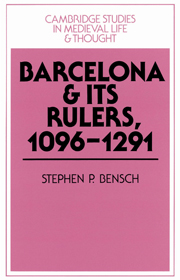Book contents
- Frontmatter
- Contents
- List of figures
- List of maps
- List of tables
- Preface
- List of abbreviations
- Introduction
- 1 The city and its region
- 2 The city and its lord
- 3 An aborted take-off: the urban economy in crisis, 1090–1140
- 4 Urban society in transition
- 5 The patriciate in gestation, 1140–1220
- 6 Family structure and the devolution of property
- 7 Consolidation and conflict: patrician power and Mediterranean expansion, 1220–1291
- 8 Patrician continuity and family identity
- Conclusion
- Appendix 1 Vicars of Barcelona
- Appendix 2 Bailiffs of Barcelona
- Appendix 3 Coinages and exchange values
- Appendix 4 Select documents
- Appendix 5 Select genealogies
- Bibliography
- Index
- Cambridge studies in medieval life and thought
Appendix 3 - Coinages and exchange values
Published online by Cambridge University Press: 08 December 2009
- Frontmatter
- Contents
- List of figures
- List of maps
- List of tables
- Preface
- List of abbreviations
- Introduction
- 1 The city and its region
- 2 The city and its lord
- 3 An aborted take-off: the urban economy in crisis, 1090–1140
- 4 Urban society in transition
- 5 The patriciate in gestation, 1140–1220
- 6 Family structure and the devolution of property
- 7 Consolidation and conflict: patrician power and Mediterranean expansion, 1220–1291
- 8 Patrician continuity and family identity
- Conclusion
- Appendix 1 Vicars of Barcelona
- Appendix 2 Bailiffs of Barcelona
- Appendix 3 Coinages and exchange values
- Appendix 4 Select documents
- Appendix 5 Select genealogies
- Bibliography
- Index
- Cambridge studies in medieval life and thought
Summary
Monetary conversions during the twelfth and thirteenth century in Catalonia raise special problems since both gold and silver coins were in circulation. Characteristic of Catalonia was the use of the solidus as a money of account rather than the pound (I lb. = 20s.). Originally the solidus of Barcelona was both a coin and a money of account, but by the eleventh century only denars and obols were actually minted. Both the silver content and the weight of the denar fell in the tenth and early eleventh century, but from the reign of Ramon Berenguer I (1035–76) until the institution of a slightly debased quaternal coinage (four parts fine, 44s. to the mark) c. 1174, the denar remained relatively stable in value. King Alfons I's quaternal coinage was cited at 1 mbt. = 7s., while the older coinage was valued at 1 mbt. = 6.1s., although sometimes slightly higher equivalences are given. Since no new coinage was issued between the mid-eleventh century and Alfon's reformed coinage, the conversion used is 1 old s. = 1.15 quaternal s. Except for a brief and unsuccessful attempt to institute a debased coin known as the bossonaya by King Pere I in 1209 and 1213, the quaternal coinage remained in circulation until 1222, when King Jaume I issued a new denar known as the dublenc (2 parts fine, 88s. to the mark). In 1258 the king issued a stronger ternal coinage (three parts fine), which remained the stable money of Barcelona in the later Middle Ages.
- Type
- Chapter
- Information
- Barcelona and its Rulers, 1096–1291 , pp. 412 - 413Publisher: Cambridge University PressPrint publication year: 1995



